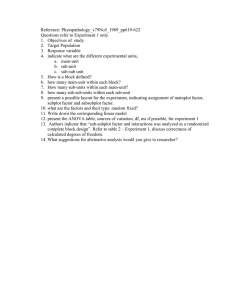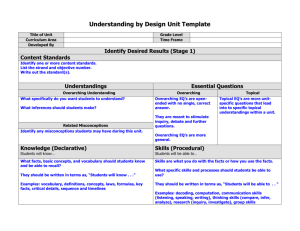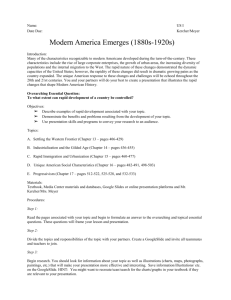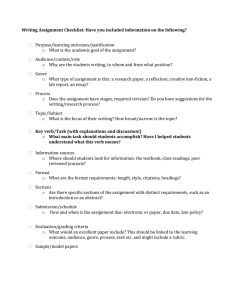UNIT MAPPING ASSIGNMENT DUE NOVEMBER 10
advertisement
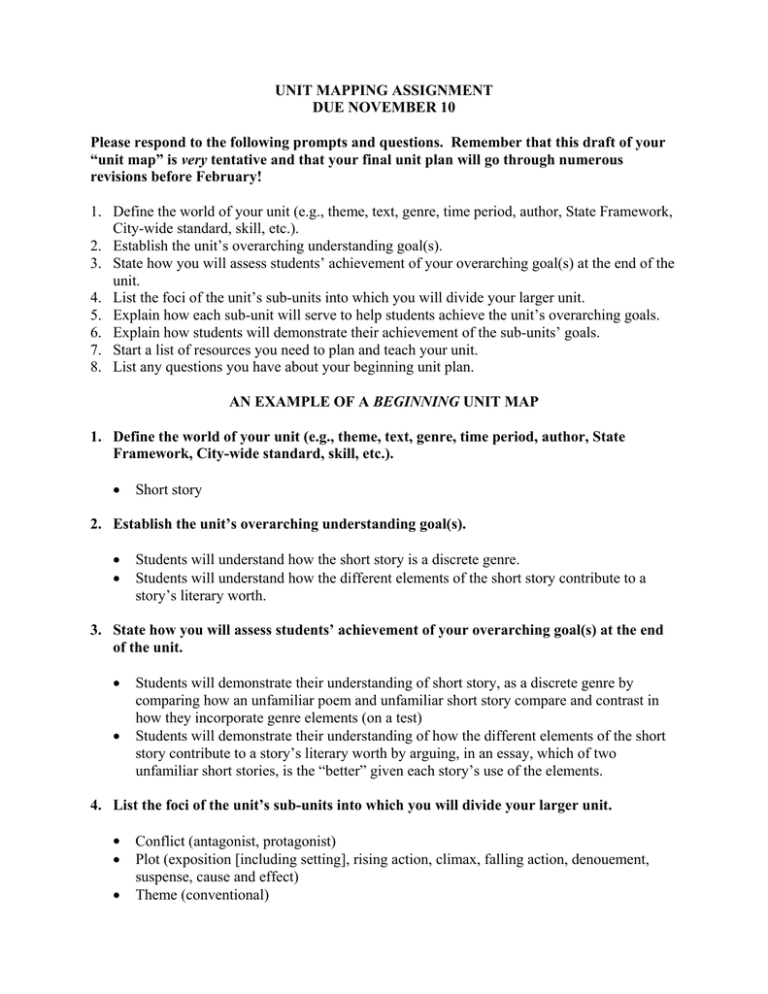
UNIT MAPPING ASSIGNMENT DUE NOVEMBER 10 Please respond to the following prompts and questions. Remember that this draft of your “unit map” is very tentative and that your final unit plan will go through numerous revisions before February! 1. Define the world of your unit (e.g., theme, text, genre, time period, author, State Framework, City-wide standard, skill, etc.). 2. Establish the unit’s overarching understanding goal(s). 3. State how you will assess students’ achievement of your overarching goal(s) at the end of the unit. 4. List the foci of the unit’s sub-units into which you will divide your larger unit. 5. Explain how each sub-unit will serve to help students achieve the unit’s overarching goals. 6. Explain how students will demonstrate their achievement of the sub-units’ goals. 7. Start a list of resources you need to plan and teach your unit. 8. List any questions you have about your beginning unit plan. AN EXAMPLE OF A BEGINNING UNIT MAP 1. Define the world of your unit (e.g., theme, text, genre, time period, author, State Framework, City-wide standard, skill, etc.). • Short story 2. Establish the unit’s overarching understanding goal(s). • • Students will understand how the short story is a discrete genre. Students will understand how the different elements of the short story contribute to a story’s literary worth. 3. State how you will assess students’ achievement of your overarching goal(s) at the end of the unit. • • Students will demonstrate their understanding of short story, as a discrete genre by comparing how an unfamiliar poem and unfamiliar short story compare and contrast in how they incorporate genre elements (on a test) Students will demonstrate their understanding of how the different elements of the short story contribute to a story’s literary worth by arguing, in an essay, which of two unfamiliar short stories, is the “better” given each story’s use of the elements. 4. List the foci of the unit’s sub-units into which you will divide your larger unit. • • • Conflict (antagonist, protagonist) Plot (exposition [including setting], rising action, climax, falling action, denouement, suspense, cause and effect) Theme (conventional) • • • • • • Foreshadowing (symbols and imagery) Characterization (through “physical description…, description by another character [or the narrator]…, [d]ialogue or presentation of a character’s conversations, …explanation of a character’s inner thoughts, [t]he behavior or actions of the character, [t]he character’s responses and reactions to each other or to situations, [a] combination of these methods.” [Laubacher,S.E. & Lodge, R.A. A Book of Short Stories – 1. New York, NY: o Harcourt, Brace & World, Inc., 2-7; quotation from p. 4.)] Point of view Verisimilitude (Poe) The interrelation of elements of the short story 5. Explain how each sub-unit will serve to help students achieve the unit’s overarching goals. To meet the overarching goals of students’ understanding short story as a discrete genre and of a story’s literary worth, students must have opportunity to define, identify, and apply their understanding of each element’s contributions. Each sub-unit is an element of the short story. The final sub-unit recognizes the interrelation of the individual elements. 6. Explain how students will demonstrate their achievement of the sub-units’ goals. I have structured the sub-unit demonstrations of understanding in the same way that I will structure the overall unit’s demonstration of understanding. • • • • Students will demonstrate their ability to define the elements of short story by providing a concise definition of each on a test. Students will demonstrate their ability to identify elements of short story by correctly labeling examples of each element and by locating examples of each element in an unfamiliar short story (on a test). Students will demonstrate their understanding of how an element defines short story as a genre by comparing the short story’s use of the element with a poet’s use of the element. Students will demonstrate their understanding of how the author’s use of an element defines the literary worth of a story by arguing, through a short essay, whether or not a particular author’s use of the element in one short story is skillful. 7. Start a list of resources you need to plan and teach your unit. • • • • • • • Short stories to use for each element and for the larger on-going analysis. Books on how to teach short story Books on the elements of short story Teachers’ ideas for teaching short story (English Journal, interviews? My Mentor’s files?) Laminated definitions of each element Laminated examples of elements A poem for the demonstration of the overarching goals 8. List any questions you have about your beginning unit plan. • • • • • • • • • AM I EVEN ON THE RIGHT TRACK?! How many short stories should I use? One per element or two or three longer short stories that allow students to examine more than one element at a time? Is it ok to read some of the stories aloud to students while they listen using a guiding question or is it better to have them read the stories to themselves? What are good resources for very short stories? Are their magazines/books of short stories that adolescents have written? What books can I find that talk about the elements of short story? Am I going to bore the students to death going element by element? How can I be sure that I don’t deaden their enjoyment of reading short stories just to “experience them?” Should I make “reading short stories for enjoyment” one of my overarching goals? How long is this unit going to last? Are there ways of teaching the elements of short story more expediently than element by element?
